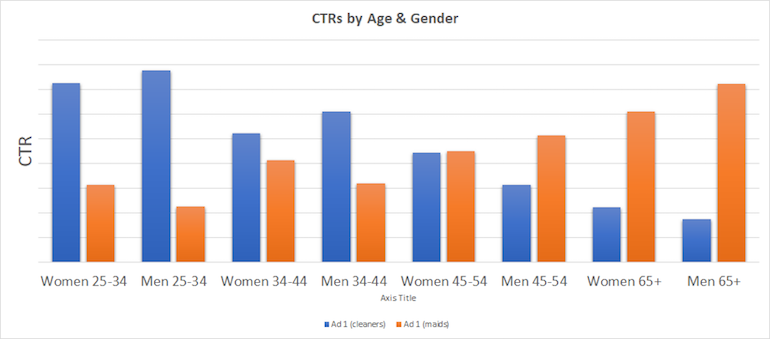February 21, 2018
Brad will be featured at Hero Conf Austin for his April 16 keynote presentation, “Personalized Marketing in an Audience Centric World”. Register to see him live!
Imagine you’re sitting in your house or apartment relaxing after a hard day at work. You look around and the place is a mess. You don’t have the energy to clean it; so you do what everyone else does – you pick up your phone and search for a maid service to come to your place and clean it up for you.
Once you conduct your search; these two ads sit atop the search results, which do you pick?

Odds are, you have now told us a key component of your demographics. It’s not 100% foolproof by any means; but this was a simple test run by a cleaning company.

In aggregate, we get this information:
- Women like the ‘not servants’ more than men at all ages, yet at older demographics, the word ‘maid’ is more likely to be used and clicked on.
- At younger ages, men are more likely than women to click on the ‘not servants’ ad.
- There’s a clean delineation around age 45 of a ‘switch’ in CTRs by ad
Note: the ad made no difference in conversion rates; only volume of clicks.
Without out getting into the politically correct discussion or millennial praising and/or bashing; just by being marketers who live by stats; there are some clear trends here that we should be using in our marketing efforts – and that’s audience targeting.
What is Audience Targeting?
At its core, audience targeting is just serving an ad to a group of like people based upon website behavior or individual characteristics.
When you look at most accounts and ask them if they are using audience targeting; the answer is almost always, “yes”.
If you ask them what they are doing; it’s almost always remarketing. Some are doing RLSA. Even less are using in-market or similar lists. Very few are using demographics. If they are using demographics, it’s almost always to adjust the bids or exclude a group from seeing their ads.
Most accounts are barely scratching the surface of what’s possible in audience targeting. This isn’t always the advertiser’s fault as Google does not make it easy to adjust ad text by demographics or other audience targeting options.
You can use the ‘if/default’ ads to change your ad for a single audience (but it’s an audience you defined, not age or gender); and there’s no way to scale these changes…yet.
We Live in the Age of the Consumer
Recently, Google changed who can show YouTube ads in response to advertisers pulling their budgets from YouTube. Much of the advertisers’ reaction of pulling budgets was in direct response to consumers bashing advertisers for supporting extremist content.
Google has expanded the ‘mute this ad’ program and made it easier to manage ad preferences. One of the biggest issues was consumers seeing the same remarketing ads over and over, especially after they had purchased a product.
These are good changes by Google for the entire ecosystem. However, it shows consumers pay attention to ads. As marketers, we sometimes live too close to data and not close enough to consumer behavior. Consumers are actually reading your ads, thinking about the site you are on, and paying attention to marketing.
The Future of Audiences
The future of audience targeting lies in our ability to not just customize the targeting and bidding by audiences; but also the message.
Remember, the message – the ads – are the only part of your account the consumer sees and interacts with. They don’t care about your bids, your targeting, your organizational structure – they only see and care about the message that’s delivered to them.
As marketers, our goal is to identify our market and then create advertisements and marketing messages that speak to our market in order to influence their decision making process.
The more granular you can segment your audience, the better you can create ads that influence that audience segment.
Audience targeting is still in its infancy; however, we can take advantage of so many options right now. Do you know what messages your audience wants to see? Have you segmented your audience by job, salary, age, gender, behavior, lifestyle, purchasing power, business type, repeat buying behavior, geography, or a combination of several of these options?
That’s the future of audience targeting. Segmenting audiences and then tailoring your message to that audience member.
It’s the Time of Audience Experimentation
Right now is the time to experiment with messages by audience type. It can be difficult at times as the tools are still being developed; but as each year rolls by, marketers get better and more powerful audience targeting features.
By experimenting now with how different segments interact with your ads, you will be able to scale your marketing with the new features as they roll out.
As it’s so difficult right now to scale, those who are doing the work have a definite competitive advantage.
After all, maids is a word derived from maidservant – one who will clean and serve you. Housekeepers are ones who cook and clean. House cleaners are ones who only clean your house. In the Victorian Era, in a truly grand house, all these roles reported to a Steward, someone who needed the organizational, financial, and communication skills to manage an entire estate.
Today, that’s your job, one who needs to organize accounts, bid properly, and communicate with consumers and clients. The best way to communicate with consumers is to identify them, understand them, and speak to them in their language with audience targeting features.
Closing Thoughts
If you’re looking for new audience ideas, possibilities, or just want to learn about the options and see some test results, join me and your fellow PPC marketers for Hero Conf where I’ll be keynoting about all the current and future state of audience targeting.